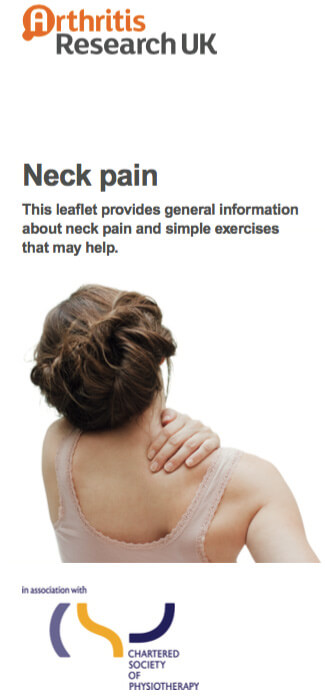Most neck pain will get better on its own within a few weeks. In the meantime, here are a few general things you can do.
Keep active
- Movement and exercise are good natural pain relievers. Keeping active reduces the impact of neck pain on your life. It's okay to feel some pain while moving.
- Some discomfort with exercise is normal and should be expected. If an exercise makes your pain a lot worse, or you get other symptoms like dizziness, you should seek advice before continuing.
- At times you may have a flare-up or marked increase in pain (this can happen whether you exercise or not). If this happens, you may be happier reducing the amount you exercise for a couple of days, but try not to stop completely. As the pain eases, try and build back up to your previous level as soon as you can.
Stay at work or get back to work and normal daily activities as soon as you can
Being at work helps you to focus on things other than your neck. Being at work is good for your general health too.
Move your neck
- Gentle movements (starting as soon as possible) will help to reduce pain and spasm and help you regain full range of motion. Movement also helps healing.
- Move your head often and gently in all direction. Relax as you move. It's okay to feel some pain but don't force the movement. Tuck your chin in, turn your head from side to side, bend your head forward and back.
- See Neck pain and stiffness exercises.
Hot or cold compresses
You can try using hot and cold to reduce your pain, whichever one gives you the most relief. Alternating heat and cold may help.
- Apply ice or cold packs to the painful area for 10–15 minutes every few hours. Wrap a plastic bag of ice (or a bag of frozen vegetables) in a damp cloth or light towel. Never place ice directly on your skin.
- Apply a moist, warm compress or a warm wheat bag to the painful area for 20–30 minutes several times a day. This should be warm but not hot to reduce the risk of burning.
Massage
When you have neck pain your neck may become stiff. Massage can help you to relax and move your neck more. Massage the area gently with your fingers for several minutes. Massage shouldn't make your pain worse.
Medicines
Most neck pain settles quickly without medicine. Medicines can be used to supplement other things that you're doing for neck pain, but often don't provide much additional benefit and can be harmful long-term. Medicines such as paracetamol or non-steroidal anti-inflammatories (NSAIDs) can help to ease the pain and keep you active. However, NSAIDs are not suitable for everyone and are usually not recommended on an ongoing basis. Common examples of NSAIDs include ibuprofen, diclofenac and naproxen. Read more about pain relief medicines..
Physiotherapy
If your symptoms don't improve over a week or so, you may see a physiotherapist for advice on specific neck exercises to do at home.
Apps reviewed by Healthify
You may find it useful to look at some Neck exercise apps.







